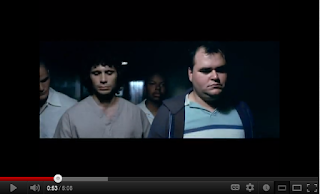Film Review for "INSiDE" A Short Film
"INSiDE" by Trevor Sands is a short film highlighting the identity crisis of a man with multiple personality disorder. It's a fascinating view on the struggles of people with mental-disabilities such as this. It is perceived that each "personality" is depicted as an individual person within the same room as him. Each figure has the ability to control Daniel's ability to speak, thus creating the illusion that he's talking to himself, yet in his mind, others talk for him.
The first shot in the film is of a blurred out image of what appears to be a window (Figure 1). This intentional blur and open framing allows the viewer to wonder about possibly the setting of this film. It turns out to be a door, and we see two mental ward assistants entering a room to assist our main actor to his feet. (Figure 2) The lighting in this shot applies a bit of subtle characterization for the main character. The dark, black shadows around the ring of light in which he sits in could imply he is lost in terms of his psyche. We could also relate to the isolation and emotional despair he may have been affected by during his stay here.
(Figure 1)
(Figure 2)
Here the assistants take the main character down a dimly lit hallway. (Figure 3) Again the lighting is very low-key, almost black except for the single hanging light every couple feet or so. This creates such shadows that the two figures are entirely silhouetted and the main character is exposed to the light. You could say in this case he's facing the light, a possible metaphor relating his visit with the doctor to some kind of judgment or death sentence. As they walk down the hallway, the single lights give short bursts of light, then back into complete darkness as they continue. (Figure 4) This plays as a sort of revealing/concealing tool that the director effectively takes advantage of when we see the character's multiple personalities walking among them one by one. (Figure 5, 6, 7) At the same time, we can hear indistinct chatter which can be interpreted as the different thought of each personality. However among the chatter we could also hear a doctor describing the character's case of multi-personality disorder.
(Figure 3)
(Figure 4)
(Figure 5)
(Figure 6)
(Figure 7)
The doctor's voice over serves as a sound bridge into the next scene, in where we see her addressing our character's multiple personalities. (Figure 8) The camera begins to do a slow truck and pan to reveal all the figures being represented as the different personalities. (Figure 9) In Figure 10, one of his personalities had taken control of his speech, and began making threats. This depicts our character as evil, or dark, depicted by the heavy cast shadows across his face.
(Figure 8)
(Figure 9)
(Figure 10)
The shadows across his face lessen when he makes a small connection to his true self. This is when he figures out his first name starts with a "D". He looks to the sky and attempts to ignore the other personalities which is observed when the indistinct chatter among them lowers underneath his own and the doctor's voice. Also a discreet "ding" noise is heard when the connection is made. (Figure 11) However this slowly builds into a climactic point when the chatter volume is being raised at an increasing rate. The shot lengths at this point also begin to shorten, making the film more fast-paced and upbeat. This speeds up to an abrupt halt, when the doctor slams the table and stands up, then proceeds to address the personalities, rather than our character. (Figure 12)
(Figure 11)
(Figure 12)
After a few close ups, we see another wide shot of the office. Although a very small office, the sudden disappearance of the personalities make the office seem large and empty. (Figure 13) An over the shoulder shot following their conversation reveals a man coming into the office. (Figure 14) When it turns out that this man is the real doctor, it comes back to Daniel, exposing the previous lady as another one of the personalities within Daniel's psyche. Also, the angle at which this shot was taken was very low. This makes Daniel, but more importantly the woman seem more powerful and superior. (Figure 15)
(Figure 13)
(Figure 14)
(Figure 15)
This ends the film with an open question to the viewer. Did Daniel adapt the woman as a new personality, or was she always present within Daniel's mind? This type of directive technique makes this film superb and mind-blowing in how the exposition of events were carried out. I highly enjoyed this film and would suggest it to anyone of interest.














